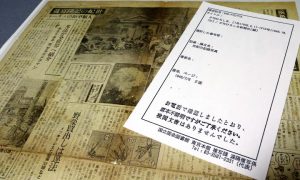Striving to fill voids in Hiroshima, Chugoku Shimbun and the press code — Surveillance of articles with A-bombing content, Part 11: First publication of photos from August 6
Aug. 5, 2023
Missing censored documents
Only five photographs are in existence that clearly capture the devastation as it was in downtown Hiroshima on the day of the atomic bombing. The photos were taken by Yoshito Matsushige, a Chugoku Shimbun photojournalist who died in 2005 at the age of 92.
The photos were revealed for the first time on July 6, 1946, the year after the atomic bombing. They appeared on page two of the evening newspaper Yukan Hiroshima, which was published by a separate company under the Chugoku Shimbun umbrella. An article with headlines that included “Documentary photos of the century” appeared with three of the photos. Two had been taken by Mr. Matsushige at Miyuki Bridge, 2.2 kilometers from the hypocenter.
Six days later, article deemed to violate press code
The reason the photos were published at that time was the existence of the press code. The Yukan Hiroshima, which was first published in June 1946 with a focus on local events and stories, was one media organization that had to undergo post-print censorship. Concerns about censorship can be discerned from the content of the article.
The article mentioned the iconic U.S. graphical magazine “Life,” under the subtitle “U.S. magazine introduces photos to the world.” The article goes on to say, “We hoped to have the article published in Life by paying a copyright fee of 10,000 dollars, but they rejected the idea.” Such language was apparently a means of circumventing censorship. The magazine was first able to publish the article in September 1952, after the end of the occupation.
Even with the indirect language, the article was apparently deemed to be a violation of the press code. Kiyoko Horiba, a poet from Hiroshima who has done research into the censorship of documents related to the atomic bombing, pointed this out in her book titled Kinjirareta Genbaku Taiken (in English, ‘The forbidden A-bombing experience’), published in 1995.
Ms. Horiba visited the University of Maryland’s Gordon W. Prange Collection in the United States and found an “unofficial memorandum” issued by the General Headquarters of the Allied Powers (GHQ). It was dated six days after publication of the article. According to her book, the rationale for the violation included “some parts being disturbing” and “some parts being based on rumors and anti-United States.”
We tried to locate the memorandum and other censored documents for this article series, but we were unable to find them. We were told that they in fact did not exist.
Censorship documents believed to have been lost
Japan’s National Diet Library in Tokyo indicates it has microfilmed and archived the entirety of the vast volume of materials censored under the occupation that remain in the collection. Upon requesting access to the material, we were able to obtain copies of the article but were told that the key documents involving the censorship did not exist. However, other articles published in the Yukan Hiroshima that were found to be in violation of the press code contained censorship documents. A staff member in the library’s constitutional documents room replied, “The reason for that is unclear.”
The actual article could very well be in the collection. When we inquired by email, however, someone in charge replied, “We looked but haven’t found anything at this time.”
According to Ms. Horiba, she surveyed the collection intensively in 1981. The microfilming of the information was carried out between 1993 and 1996. The person in charge of the collection speculates that censorship documents were somehow lost between the time the survey was conducted and the microfilming work.
After Japan’s occupation ended, publications submitted from all over Japan for censorship scrutiny by GHQ were transferred to the University of Maryland in the United States. The materials were named the Gordon W. Prange Collection and kept in storage. Many of the actual materials do not exist in Japan. With magazines as an example, the National Diet Library’s holdings of actual articles are thought to account for about 20 percent of the total number in the collection.
Taketoshi Yamamoto, professor emeritus at Waseda University who is an expert on media censorship during the occupation, emphasized, “The newspapers, magazines, and books that were subject to censorship are valuable documents that record the history and culture of the immediate postwar period. They are irreplaceable assets of the people of Japan.” With the present situation in mind, we hereby propose that the U.S. side return the materials and that Japan’s government take responsibility for their preservation and management. We also seek the creation of a system that is easily accessible to the public.
Incidentally, regarding the article, Mr. Matsushige had been summoned to the Hiroshima field office of the GHQ. Before he died, he said, “I was told, ‘We wish you had received permission (to publish) in advance,’ and ‘We would like copies of the photos.’” He added, “The response was less severe than I had imagined.” This interesting episode sheds light on the true nature of censorship of articles involving the atomic bombing.
(Originally published on October 5, 2023)








